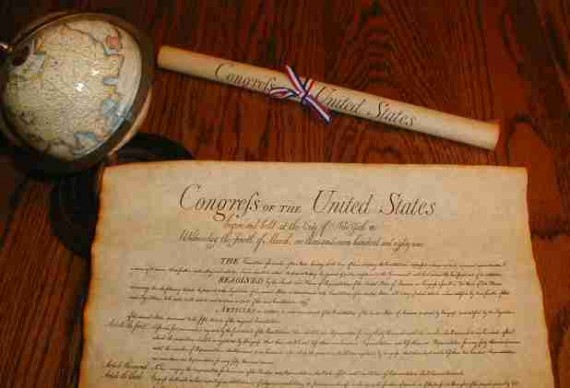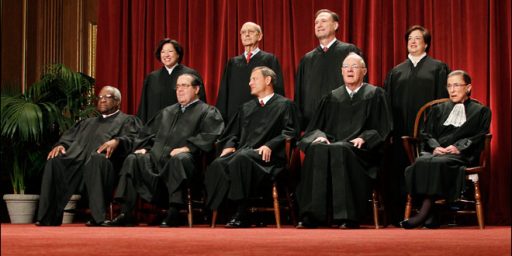Supreme Court Searches For Dividing Line Between Free Speech And Illegal Online Threats
The Justices of the Supreme Court seemed to struggle yesterday to find an easy way to draw a line between protected speech and the kind of threats that are not protected by the First Amendment.
Yesterday, the Supreme Court heard oral argument in the online threats case that I wrote about last week and, as I suspected, much of the time was taken up with the Justices using their questions to the attorneys for both sides in an effort to puzzle out some kind of standard that could be applied that would distinguish between protected speech and a criminal threat:
WASHINGTON — As the Supreme Court on Monday tried to puzzle outwhat threats may be prosecuted as crimes, Chief Justice John G. Roberts Jr.cited an unlikely source: the rapper Eminem.
Treading gingerly, the chief justice quoted vivid lyrics from “ ’97 Bonnie and Clyde” in which Eminem seems to threaten to drown his wife.
“Could that be prosecuted?” Chief Justice Roberts asked Michael R. Dreeben, a government lawyer.
Mr. Dreeben said no and started to say something about context. Chief Justice Roberts interrupted.
“Because Eminem said it instead of somebody else?” he asked.
The case before the justices also involved threatening rap lyrics arising from domestic troubles. They were posted on Facebook by Anthony Elonis, a Pennsylvania man who had adopted the rap persona Tone Dougie. The posts, long tirades in the form of rap lyrics, were punctuated by brutally violent language, most of it directed against his estranged wife.
He wrote that he would like to see a Halloween costume that included his wife’s “head on a stick.” He talked about “making a name for myself” with a school shooting, saying, “Hell hath no fury like a crazy man in a kindergarten class.” He fantasized about killing an F.B.I. agent.
(…)
John P. Elwood, a lawyer for Mr. Elonis, said his client’s posts included elements of entertainment. Justice Samuel A. Alito Jr. responded warily.
“This sounds like a road map for threatening a spouse and getting away with it,” Justice Alito said. “You put it in rhyme and you put some stuff about the Internet on it and you say, ‘I’m an aspiring rap artist.’ And so then you are free from prosecution.”
The Supreme Court has said that “true threats” are not protected by the First Amendment, but it has not been especially clear about what counts as such a threat. Justice Anthony M. Kennedy said the term itself was unhelpful.
“I’m not sure that the court did either the law or the English language much of a good service when it said ‘true threat,’ ” he said. “It could mean so many things.”
The question for the justices in Monday’s case, Elonis v. United States, No. 13-983, was whether prosecutors had done enough to prove Mr. Elonis’s intent. Mr. Dreeben, the government lawyer, said the words and their context were enough.
The standard proposed by the government, he said, would hold people accountable “for the ordinary and natural meaning of the words that they say in context.”
(…)
Monday’s argument was mostly about calibrating and articulating the right level of intent, and it seemed that many of the justices were looking for something between mere negligence and purposeful conduct. There was perhaps the beginning of a consensus that it would be enough to require prosecutors to prove that Mr. Elonis had been subjectively aware that his posts would scare and disturb his wife.
The court could ground such a ruling in the First Amendment or in interpreting the federal law on threats, though the latter seemed more likely.
But some justices seemed nervous about placing too stringent a burden on prosecutors.
“How does one prove what’s in somebody else’s mind?” Justice Ruth Bader Ginsburg asked. “In this case, the standard was ‘would a reasonable person think that the words would put someone in fear?’ and reasonable people can make that judgment. But how would the government prove whether this threat in the mind of the threatener was genuine?”
Lyle Denniston has more:
The federal government wants the Court to rule that, if a “reasonable person” would interpret an Internet rant as a threat, that should be enough to get a criminal conviction. But the lawyer for a Pennsylvania man convicted of making threats on Facebook wants the Court to declare that his client had to intend specifically that his words would be taken as a threat, and he knew it.
The gaping distance between those two positions led the Court to explore intermediate possibilities — whether “purpose” should count, ” whether “knowledge” was enough, whether mere “recklessness” would suffice. If that were not challenging enough, the Court struggled to figure out, if they opted for a “reasonable person” to test the meaning of menacing words, exactly who that would be. Would it be necessary to use a teenager addicted to the Internet to judge a teenager who sent a message with threats included? Who would judge whether a rant was only a rap, as in rap music with violent lyrics?
To decide the case, the Court does have to settle on a definition of proof, because the language of the federal law at issue seems — if applied literally — to say that any threat of harming someone else is criminal, but the Court has insisted that the law only applies to “true threats.” How to know, then, when a threat reaches the level of being true or real?
John P. Elwood, a Washington, D.C., lawyer arguing for a “specific intent” requirement, had to deal with such a flurry of often-contradictory questions from the bench that he barely could make a consistent argument, and was told more than once that he was not arguing what he should have been, or what one Justice or another expected him to argue.
Deputy Solicitor General Michael R. Dreeben, the federal government’s premier courtroom advocate on criminal law, at times seemed to have the Court leaning his way because of the emphasis he was putting on the targets of online rants, but at other times seemed to be pushing his argument well beyond what even a First Amendment-sympathetic Court would find comfortable.
Justice Elena Kagan, for example, told Dreeben that the Court would normally want to set up a kind of “buffer zone” between the First Amendment and criminal prosecution but, she noted, the government was having none of that. Dreeben did not back off; what this case was dealing with, he said, were “criminal threats that did not have First Amendment value.”
Justice Stephen G. Breyer, who may be the Court’s most knowledgeenable on the intricacies of criminal law, suggested — somewhat unhelpfully — that the First Amendment be put aside so that the focus could be on “the ordinary criminal code” and the proof necessary for guilt. But the whole reason that the Court has narrowed the threat-by-communications law to apply only to “true threats” is because of concerns over how much innocent speech might wind up getting prosecuted.
Although the Justices did not spend a lot of time analyzing whether the Internet was different from other forums of communications, now and then a Justice would throw in a presumably knowing reference to Eminem or to rappers more generally. Dreeben dismissed the supposed “chilling effect” on rappers by saying they simply would not be prosecuted for using violent lyrics, because that was supposed to be “entertainment.”
As Amy Howe notes in her “Plain English” summary of the oral argument at SCOTUSBlog, it’s hard to read where the Justices are on this case based on the oral argument, although as I have noted before it’s always risky to try to predict which way any Court may be leaning on a particular case based on oral argument alone. Nonetheless, the questioning and the back and forth between the Justices and the attorney for both sides seem to indicate that the Court came into oral argument perhaps struggling with the idea of how to craft a standard based on the true threat doctrine that would not be overly protective of actual dangerous threats that could erupt into violence while at the same time not restricting legitimate creative expression or what might just amount to “blowing off steam” in the semi-anonymous world of the Internet. To say the very least, the Justices seemed skeptical of the purely subjective-to-the-speaker standard that Elonis’s attorneys are arguing in favor of, not the least because of the fact that it would be incredibly difficult for the government to prove what is in the mind of the speaker beyond his or her own self-serving testimony about the matter, and it would be even harder for the trier of fact to determine. Even Justice Ginsburg was skeptical on that point. At the same time, though, many of the Justices, with the exception of Justice Alito, who as Howe points out has been the sole dissenter in several of the Court’s First Amendment cases dealing with unpopular speech such as the Westboro Baptist Chuch case and the case dealing with so-called “crush” videos, were skeptical of a standard that relied solely on the question of whether or not the speech in question created fear in the mind of the alleged target of the speech. Other Justices, such as Justice Kagan, spent time trying to craft some kind of middle ground standard, but it was clear that none of them had really even convinced themselves that the ideas in their head were workable.
The Court is likely to take some time with this case given the fact that whatever they decide is going to have a significant impact going forward. If they come down on Elonis’s side, or somewhere close to it, then it is going to make it difficult if not impossible to prosecute anytime under the statute in question.. If they end up adopting the standard the government wants, though, it could end up putting in Federal Prison people who don’t really belong there and silencing speech that ought to be protected by the First Amendment. Given how they’ve handled these cases in the past, the most likely outcome would be that the we’ll see a majority of the Justices come down on the side of the First Amendment and adopt a standard that is likely to allow for a standard that makes prosecution harder. Given the fact that the First Amendment would seem to argue that the balance should come down on the side of free speech, that would seem to me be the best outcome under the circumstances. In either case, this case is likely to take some time for an opinion so I wouldn’t expect anything until sometime in the spring of 2015 at the earliest.
Here’s the transcript:






Wouldn’t intent be a major factor? Using the Eminem example, the intent of the lyrics had threatening overtones but were not addressed to the lady in question but rather were released for pay under a professional label. He didn’t send them to her house, post them on her Facebook page, or otherwise directly verbalize them to her. There’s also the physical factor to take into account – did Eminem have the ability, desire or intent to follow through on these threats or was he “throwing shade”?
Facebook is a group of people you chose to link to – in other words, a cohort you create for yourself (unless your settings are crap). It’s not the mass public like someone hearing an Eminem song on the radio. Thus, by posting these to Facebook there is a fairly reasonable assumption that Elonis intentionally meant for his wife or someone associating with his wife to see them. The intent is much stronger here along with the probability that these are direct threats meant in a challenging and menacing manner. Additionally, when did he adapt the persona? Is this a long standing hobby of his or did it start about the estrangement? Facebook should have that on his timeline – when did Tone Dougie emerge?
Don’t stand your grounds have as their basis that if a person “reasonably fears” (whatever that means) for their safety they have a right to kill whoever is making them fearful? Just apply the same standard to this situation, and Judges and Prosecutors won’t have to trouble themselves with intent at all.
Problem solved. Your Welcome Chief Justice Roberts and company.
@OzarkHillbilly: “Stand your ground laws”!!!! Stupid Alzheimers.
In 1966, after a jury trial in the United States District Court for the District of Columbia, Watts was convicted of violating a 1917 statute which prohibits any person from “knowingly and willfully . . . [making] any threat to take the life of or to inflict bodily harm upon the President of the United States . . . .” when during political debate at small public gathering that if inducted into Army (which he vowed would never occur) and made to carry a rifle “the first man I want to get in my sights is L. B. J.” The Supreme Court reversed this decision.
Based upon the governments position in this case, if Watts made the same statement today on the internet, he should be guilty if a “reasonable person” would interpret an Internet rant as a threat, that should be enough to get a criminal conviction.
The government’s position here leaves no room for considering ones actual ability to carry out said “threat”, much less the if-then statement which predicates a condition be met in the future before the action would occur.
This is by definition, the slippery slope.
@OzarkHillbilly: No. That’s not how that works.
I think we’ve pushed far too much in the pro-First Amendment direction. How many women have to be killed by their pissed-off spouses before we start acknowledging that threats are in fact, threats?
First Amendment doesn’t mean you get to phone in threats to bomb a school or slaughter people and then, when the police show up at your door, wave a big smiley face in their direction and say: “just joking!”
If you want to blow off steam with threats of murder, do it in your own journal, and don’t put it on line. As soon as you deliberately put such a threat out there with the attempt to scare someone else, it’s not a First Amendment issue anymore. It’s IIED.
This is a very interesting debate. CNN is reporting that Louis Head, Michael Brown’s stepfather, is being investigated to establish whether he was inciting to riot when he told a crowd of protesters to “Burn this b!tch down!” Could his lawyer argue that he was speaking metaphorically? The burning certainly did ensue; a number of businesses were torched. Did Head cause that to happen with his words?
What about statements made in the heat of the moment? They’re certainly threatening. But are they serious?
As a writer, I tend to be wary of any attempt to restrict free speech. I’m reminded of a case about fifteen years ago where some guy committed a horrendous murder, and then tried to blame it on a novel he’d read recently. (“The author made me do it!”) That went nowhere as a defense, of course, but the fact that someone would raise it is unsettling.
A lot of rap music contains threats to kill, or boasts about killing. Is it art, or is it schlock? That said, Tone Dougie/Anthony Elonis sounds dangerous.
I think a reasonable person standard is fine. Terrorizing people, online or off, really isn’t appropriate or acceptable.
Does this mean that an aspiring rap artist cannot use his recent messy breakup as a catalyst for their work? No, it just means they can’t use their aspiring career as a tool to terrorize their ex. Put it in context so it isn’t taken as a threat.
If you post something in rhyme about cutting off someone’s head and carrying it on a spike, well, then maybe you need to post something else not dripping with anger where you say that you’re using the breakup to explore your dark places. Something so a jury of your peers isn’t going to unanimously say “this is clearly a threat”.
Rights don’t come free — they have responsibilities attached. Free speech doesn’t allow libel, or incitement, and if you are doing something artistic that looks like libel or incitement, you need to put it into context. The same seems reasonable with threats.
http://en.m.wikipedia.org/wiki/Cop_Killer_%28song%29
@Eric Florack: http://en.m.wikipedia.org/wiki/I_Shot_the_Sheriff
“Will no one rid me of this turbulent priest?” Protected
“Hey Joe, I said where you goin’ with that gun in your hand?
Alright. I’m goin down to shoot my old lady,
you know I caught her messin’ ’round with another man.” Not protected
I am very conflicted about this whole subject. Would Ralph Cramden threatening to send Alice “to the moon” be protected? How about the current case in Texas where a young man used violent and threatening language on Facebook about shooting up a kindergarten? Where does the casual and hyberbolic “I’m going to kill you” stand. It really is about context and specific intent. How right is it to depend on the fear level the recipient of the language has. One person’s fear may be excessive. How will that be adjudicated?
I don’t have a single answer and I am interested in how the Supreme Court handles this.
Free speech is about politics and government suppression of political views. It’s not about harassment, fighting words, advertising, or general douchebaggery.
@Rick DeMent:
Who defines what constitutes “general douchebaggery”? What I perceive as mildly offensive might be grossly offensive to someone else. And vice versa. Or not at all.
In a side note, a man in Seattle was arrested by the FBI yesterday for making threats on Facebook against the life of Darren Wilson and other “white mothafucka” police officers. Protected speech? The bureau didn’t think so, apparently.
@Jack: Well, it didn’t work that way for Trayvon Martin, but it sure did for Zimmerman!
@Scott: But since we’re not mind readers, we usually go by the “reasonable person” standard.
Freedom of speech is a right. It also contains a responsibility with it: don’t use it to terrify people with threats.
I’d be willing to set up a registration list for all individuals who want to be able to say whatever they want without any consequences. The catch is, they are treated under the law like minor children for everything else. Want to be able to send threats to everyone? Fine. You don’t get to sign contracts, buy guns, buy cigarettes, or represent yourself in any adult capacity.
@Scott:
While I find the casual domestic abuse humor in the Honeymooners less than funny, you can threaten a fictional character to your hearts content without fear.